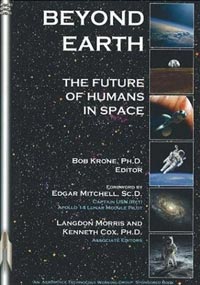|
|
Review: Beyond Earth
by Jeff Foust
Monday, July 24, 2006
Beyond Earth: The Future of Humans in Space
By Bob Krone (ed.)
Apogee Books, 2006
softcover, 296 pp., illus.
ISBN 1-894959-41-8
US$27.95
The Aerospace Technology Working Group (ATWG) is an organization established in 1990 to, in its words, provide “vision and leadership for the evolving of a growing, vital, and thriving human presence in aerospace and aeronautics”. The group, which once operated under the aegis of NASA but is now an independent organization, has attracted an eclectic array of experts focused on advanced technology and related issues associated with spaceflight. Beyond Earth, a volume of papers contributed by ATWG members, provides readers with a diverse hodgepodge of essays on the future human settlement of the solar system.
The book’s preface notes that it features “a wide variety of conceptual, philosophical, and technical viewpoints.” And that may be an understatement. Chapter titles range from “Space as a Popular National Goal” to “Harnessing Bacterial Intelligence: A Pre-Requisite for Human Habitation of Space” to “Tennis Time and the Mental Clock”. The contributors are equally diverse, although not household names for the vast majority of readers (the most prominent person, perhaps, being Apollo 14 astronaut Ed Mitchell; better-known contributors include Frank White and Tom Rogers.)
| The book’s preface notes that it features “a wide variety of conceptual, philosophical, and technical viewpoints.” And that may be an understatement. |
That broad scope is also the book’s biggest drawback. While the book is divided into three major sections (human factors, science and technology, and strategy), it is difficult for the reader to get into any sort of rhythm going through the book, with different themes, and different writing styles, from chapter to chapter—a problem with any collection of papers. The very broad scope of the book, though, exacerbates this problem: had the book focused more tightly on a specific topic, like human factors or technology, the shifts from chapter to chapter might have been less jarring.
With such a variety of material, it’s not possible in this brief review to critique every essay, but a few items do stand out. There is a theme present in several essays about the need for international cooperation in space exploration since no single country has the sufficient resources for “moving humanity into space”, but what exactly that means, and what resources are required, don’t get enough attention in the essays. Another essay criticizes NASA for not paying attention to the people who are interested in the Cydonia region of Mars (home to the infamous “Face on Mars”), thus making them feel disconnected with the space program. The essay doesn’t discuss, though, NASA’s past efforts to bend over backwards to image the region with Mars Global Surveyor in the late 1990s, or how such efforts would do anything more than add more fuel for conspiracy theories, regardless of the results. Overall, perhaps what Beyond Earth does best is to provide a sample of the universe of ideas associated with the central vision of expanding humanity into the cosmos.
Jeff Foust (jeff@thespacereview.com) is the editor and publisher of The Space Review. He also operates the Spacetoday.net web site and the Space Politics and Personal Spaceflight weblogs. Views and opinions expressed in this article are those of the author alone, and do not represent the official positions of any organization or company, including the Futron Corporation, the author’s employer.
|
|
